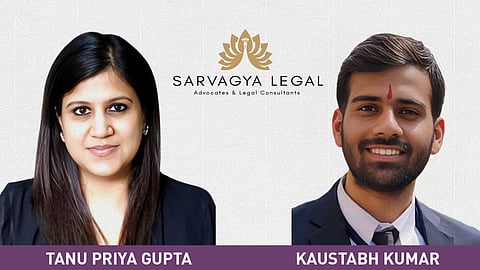
- News
- Columns
- Interviews
- Law Firms
- Apprentice Lawyer
- Legal Jobs
- हिंदी
- ಕನ್ನಡ

Election season is long over, and the dust has settled. Despite the wild speculations, our government does not have the magical “400 paar” to change the kitab. But what if they did? What could a political party do with such a significant majority in the Indian parliamentary system? More importantly, does the Constitution have any safety valves or checks and balances to protect itself in such situations?
In the Indian parliamentary system, a political party with more than 400 seats in the Lok Sabha holds a commanding majority, allowing it to pass a wide array of legislation. However, this does not necessarily grant the party unbridled power to amend the Constitution. Our Constitution is a living document and has already undergone as many as 106 amendments in the past 74+ years. This feature ensures that the Constitution evolves with changing times and, at times, aligns with the government of the day. However, there are comprehensive mechanisms and thresholds that must be adhered to.
To understand if a “400+” majority truly holds sway, let's delve into the process of amending the Constitution.
Article 368 in Part XX grants Parliament the authority to add, vary, or repeal any provision of the Constitution through a specific process distinct from ordinary legislation. An amendment of the Constitution can be initiated only by the introduction of a bill for the purpose in either House of Parliament and not in the State legislatures.
It outlines two primary methods for amending the Constitution. The first method involved a special majority of Parliament, which requires a majority of the total membership of each House and a majority of not less than 2/3rd of the members present and voting in each House. This method is commonly used for amending significant parts of the Constitution, including Part III (Fundamental Rights) and Part IV (Directive Principles of State Policy).
The second method involves a special majority of Parliament along with ratification by at least half of the State legislatures. This applies to amendments affecting the federal structure, such as the election of the President, the extent of executive power of the Union and the States, the powers of the Supreme Court and High Courts, and the distribution of legislative powers between the Union and States. Thus, for such amendments, beyond the special majority in Parliament, ratification by at least 14 out of the 28 State legislatures (assuming the current number of States) is required.
Though not contemplated in Article 368, certain provisions of the Constitution can be amended by a simple majority in both Houses of Parliament, that is, more than 50 percent of members present and voting. These amendments pertain to changes that are considered less critical to the core framework of the Constitution such as the admission or establishment of new States, creation or abolition of Legislative Councils in States, administration and control of scheduled areas and scheduled tribes, etc.
While not a formal method of amendment, judicial interpretations and constructions play a pivotal role in shaping the Constitution. The Hon’ble Supreme Court of India, through its judgments, has clarified, expanded, and sometimes restricted the meaning of constitutional provisions. For instance, the Hon’ble apex court struck down Clauses 4 and 5 of Article 329-A inserted through Thirty-Ninth Constitutional Amendment Act in the case of Indira Gandhi v. Raj Narain.
From the above, it is clear that besides Lok Sabha, seats in the Rajya Sabha are equally critical.
As of 2023, the Rajya Sabha has a maximum of 250 members: 238 elected by State and Union Territory legislatures using single transferable votes through open ballots, and 12 appointed by the President for contributions to art, literature, science, and social service. State members of the Rajya Sabha are elected by their respective State Assemblies, making it crucial to have a majority in those assemblies. Thus, State elections become as important as those of the Central Government.
Notably, the present NDA-led Government holds 117 seats in Rajya Sabha, which is four seats less than simple majority. Even if the NDA-led government had scored 400+ seats in the Lok Sabha, crucial constitutional amendments require a special majority in both the houses, which they do not enjoy in Rajya Sabha as the NDA seats are still 50 seats less than the number required to constitute a Special Majority.
Moreover, practical considerations and political dynamics often demand consensus-building, especially for amendments needing State ratification. Major constitutional amendments attract public scrutiny, compelling the ruling party to justify its changes to maintain public support. Additionally, the Hon’ble Supreme Court of India through the Kesavananda Bharati case, established that Parliament cannot amend the Constitution to alter its basic structure. Any amendment violating this doctrine can be struck down by the judiciary. For instance, the Constitution (Ninety-ninth) Amendment Act, 2014 was declared unconstitutional and void by the Hon’ble apex court safeguarding the basic ethos of judicial independence contained in the Constitution.
Thus, while a commanding majority in the Lok Sabha is powerful, it is not an absolute power.
Even “400+ supermajority” would not equate to unchecked power. The intricate balance of the Indian constitutional framework, with its emphasis on federalism, judicial oversight, and the necessity of broad consensus, ensures that even the most powerful government must operate within the boundaries of democratic principles and constitutional propriety
About the authors: Tanu Priya Gupta is an Advocate-on-Record at the Supreme Court of India and a Partner at Sarvagya Legal. Kaustabh Kumar is a legal researcher at the firm.
If you would like your Deals, Columns, Press Releases to be published on Bar & Bench, please fill in the form available here.